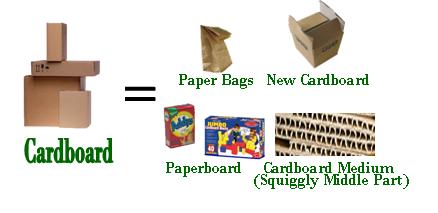Imagine what would happen if the raw materials needed to make new products were suddenly gone…we would no longer have the materials needed to make new items.
Our products would become limited, store shelves empty, and prices increasing.
Recycling protects our natural resources from over harvesting. There is no need to re-harvest raw materials, we all ready have them. We just need to use them more and NOT bury them in the landfill.
Recycling Benefits the earth:
Your recycling efforts are valued and appreciated!
Click on the links below to learn what items are recycled at the Carroll Recycling Center and what they will soon become.
All images below are used in collaboration and with approval from the Maine Department of Environmental Protection.

Plastic can be confusing to recycle, there are so many different types of containers with numbers from 1-7.
Plastics with the numbers #1, #2, #5 are the most commonly recycled plastics.
Plastic can only be recycled a few times before it loses its quality and becomes waste.
#1 plastics must be sorted and processed separately from #2 & #5 plastics.
Clear #1 and #2 bottles and jugs must be sorted separately from colored #1 and #2 bottles and jugs.
Clear plastic is more valuable than colored plastic, because it is more versatile.
It’s even confusing to recycle plastic with the same numbers! They may both have the same number, but are produced by using a different process. For example, laundry detergent and some shopping bags may both be #2 plastic, but they cannot be recycled together! They must be processed separately.

Glass can be recycled indefinitely! And it is made from raw materials that are plentiful and friendly to the planet to harvest. All types of glass food and beverage containers can be recycled to make new glass products. It is actually easier and more cost effective to manufacture new glass containers from recycled glass than it is to make new glass from raw materials!

Steel, Tin, and Aluminum Cans can be recycled indefinitely! They never lose their strength. In fact, much of the aluminum & steel we use every day has been in circulation since the late 1800’s! This powerhouse container can be recycled and back on the store shelf in as little as 60 days. Producing new cans from recycled feedstock saves 95% of the energy it would take to make this same can from ore.

Newspapers, Magazines, Mixed & Office Paper and Corrugated Cardboard are some of the most important and much needed recyclable materials. Many of our daily necessities and products, as well as the package they come in, are made using as much as 50 to 100 percent of recycled paper & cardboard. Recycled magazines provide an important link in the recycling process. They contain a high clay content that helps remove inks from the paper before it is made into a new paper product.
